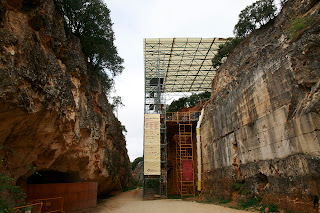On our second day in Mallorca, we had two goals: see some beautiful beaches and check out some caves. We had to walk a bit back to a bus stop that would take us to the airport. There was a marathon in town that weekend that made getting around a bit trickier. Many of the buses that pulled up to the stops where we waited were packed to the brim with tourists. Eventually, we were able to squeeze ourselves onto one that took us to the airport. Once there, we picked up a rental car and headed to the eastern part of the island. On the recommendation of a couple of friends, we went in search of an apparently mythical beach that seemed intent on eluding us.
We drove through the small towns of Llucmajor, Campos, and made our way down to the Cape of Ses Salines. We parked alongside the road and walked down to the coast. There, we found a lighthouse and a rocky coast. Lots of rocks had been stacked all along the coast. The water was a gorgeous blue and aqua as far as the eye could see. We wandered around the area for a bit and watched the waves beat on the coast and splash high in the air.From there, we headed north towards Cala d'Or in search of Cala Mitjana. It's a beautifully secluded piece of beach. There was a small house built there. We found paved trails that went around the beach and up into the woods. The water was clear and there were a few people there. The great thing about Mallorca is that you can find a secluded beach easily. Most of the tourists go to the main beaches but the smaller calas are just as nice and not overcrowded.
All throughout the countryside of the island are tons of windmills like this one. It's one of the first things I noticed as the plane got closer to landing, aside from the beautiful blue water of course.
Cala d'Or is a just a short drive south of Cala Mitjana and has more of a crowd. The wind was blowing pretty hard and made relaxing on the beach difficult. Instead of sitting around, we walked along the rock formations in search a better view. It never failed that every time we turned a corner, there was another incredible rock formation or places to watch waves crash. It was amazing.After feeling beached out, we decided it was time to head underground. There are several caves throughout the island but we chose to go to the Drach Caves. The caves consist of four caves that span a distance of 2.4 km(1.5 miles) and go 25 m(82 ft) deep. There is a large underground lake there that is thought to be one of the biggest known underground lakes in the world. That is, of course, until they discover more. The cost to get in was 11.50 each and the tours are guided. There aren't many pictures because you aren't allowed to take them and there are guides sporadically throughout the walk to make sure you don't take them. We just turned off the flash. Other idiots who don't know how to cut off their flash got caught and were made to delete the pictures.
At the end of the tour, we arrived to Martel Lake. They turned off the lights and played some classical music on a boat that came out and rowed around the lake. It was a bit eerie being in such darkness so far underground. After the concert, there is an option to cross the lake in a boat or walk along the boardwalk across. All throughout the caves, there are tons of water pools and its amazing how clear the water is. The pictures don't reflect the clear reflections very well. If you plan on visiting Mallorca, a visit to the Drach Caves is a must do.
After our visit was over, we walked to Portocristo to have some lunch. We ate a roadside stand and had some mediocre food. The town was nice but seemed a bit quiet. We returned to the car and just went on a nice countryside drive. The island really reminded us a lot of Crete.
When we got back to Palma, we stopped by the Bellver Castle. It was close to our hotel and is probably the second most famous landmark in the city after La Almudena. The view of the city from the hilltop is great and we were able to watch the sunset. The castle was built in the 14th century and is considered to be the first round castle in Europe. In addition to a view of Palma, you can see the Tramontana Sierra on the other side. It has served as a military fortification, a home to several rulers, and a prison. It's design was unique and inspired other rounded castles. It's the only rounded castle in all of Spain.
After our visit to Bellver Castle, we headed into town and had a great dinner of bacon wrapped steak and chicken. The restaurant was recommended by the Michelin guide called Cellar Sa Premsa. On Sunday, we spent the day visiting more beaches and just relaxing before catching our flight back to Madrid. Overall, we had a great time in Mallorca and it is a place we know we must visit again.
































































